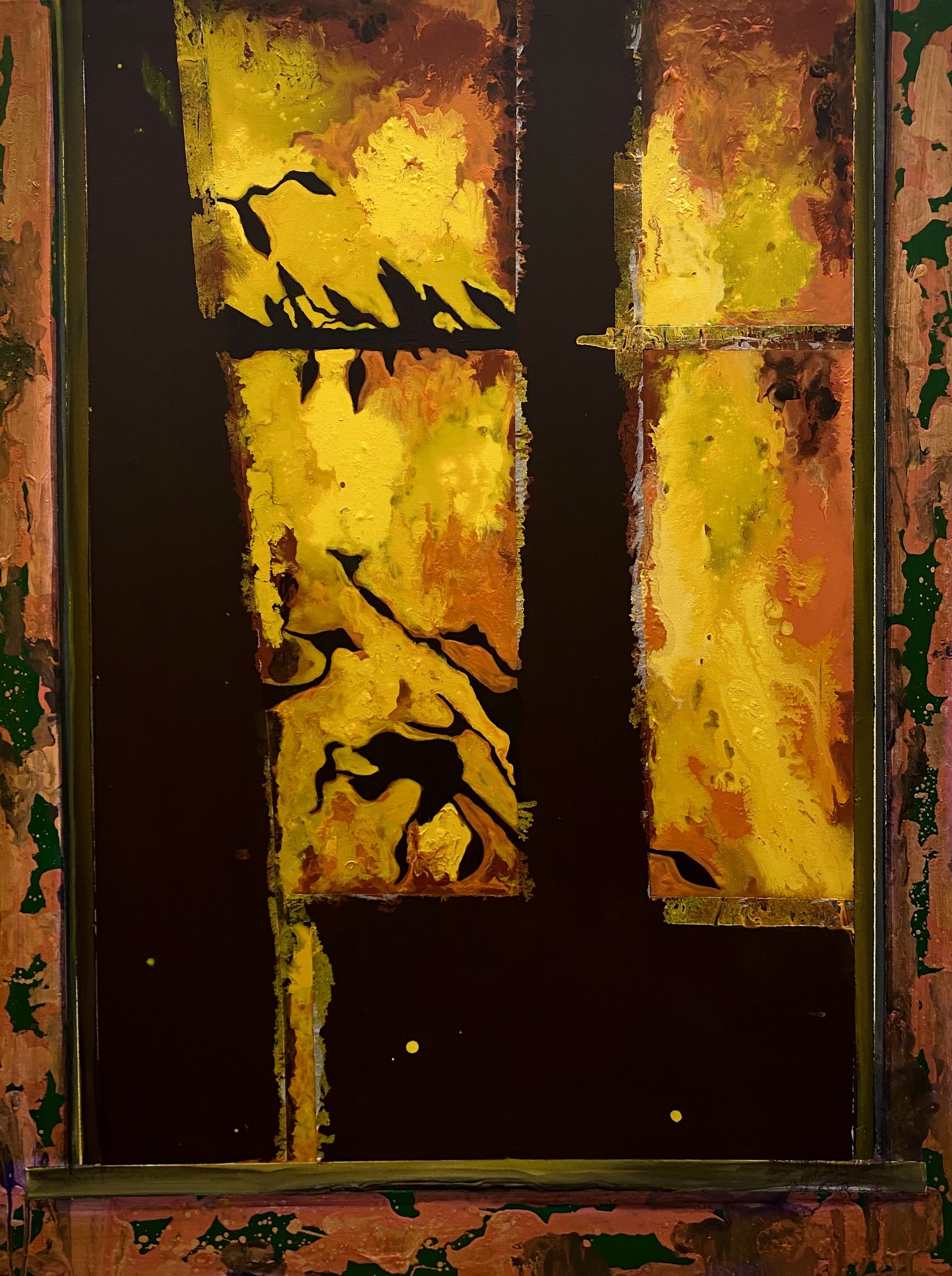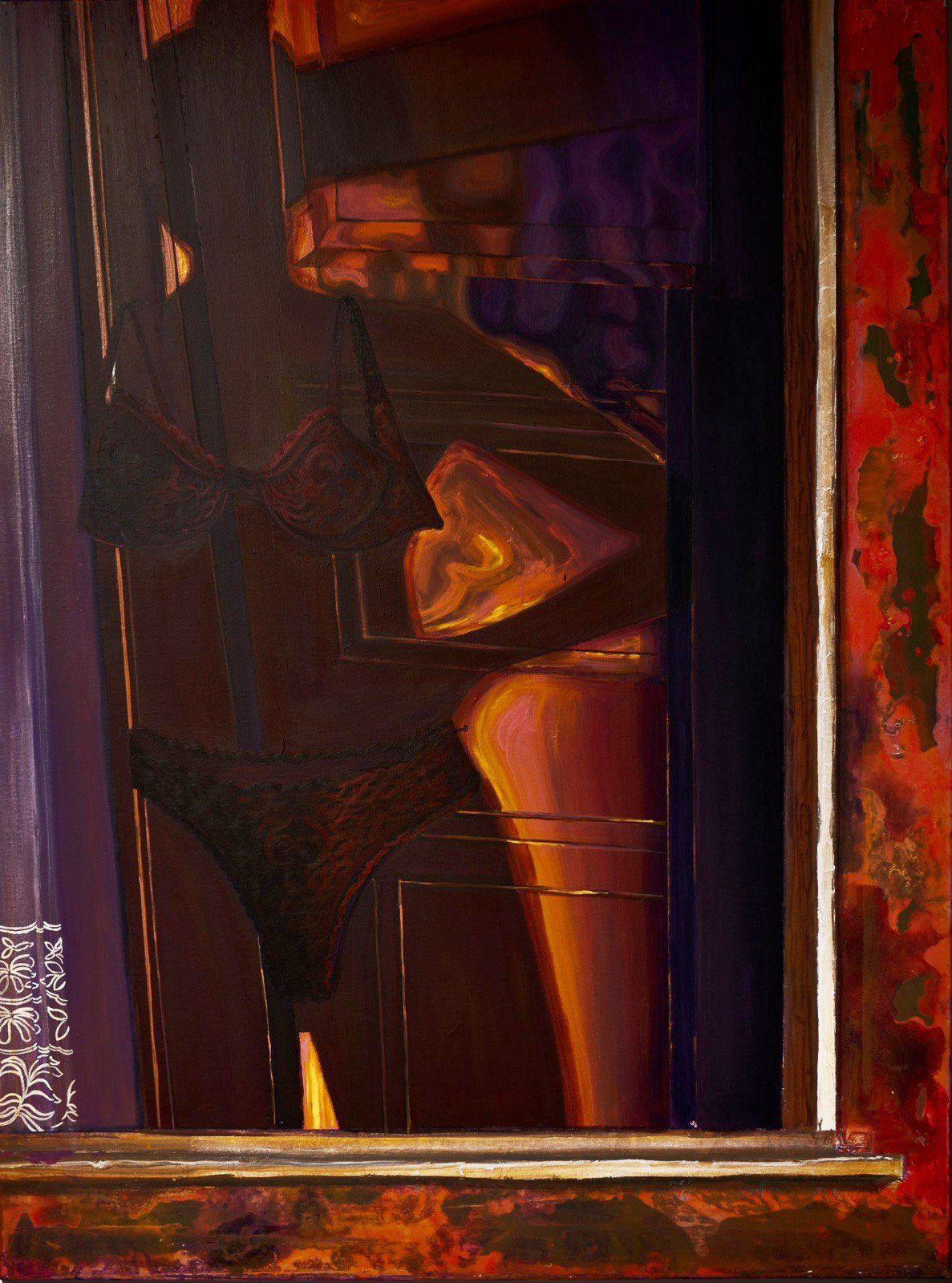Horcelie Sinda in Conversation with Artists Koby Martin
Koby Martin’s Solo show ‘Drunk Minds Speak of Sober Times’ is an aphorism, a voyeurism through the use of a window. For Martin, the window is a symbolism of a threshold between the viewer and the focal point, the uncertainty of the unknown. The show is a merging of autobiographical elements which exposes notions of diaspora, time, space and identity.
Martin is a Ghanaian-born, London based artist. His penchant for art began in his childhood and his artworks are the process of transmogrification of his experiences in Ghana and the UK. His work is an introspective autobiographical exploration of his life as he believes knowing of self is pivotal in the exploration of any subject matter, as it trickles down in the perspective of the psychological and physical things we experience daily.
Martin’s work portrays the inclusive human experience of dealing with emotions, memories, thoughts and feelings that we all undeniably feel. As his work evolves, it also tends to tackle various subject matters outside of his default conversations; including topics such as identity, social and racial injustice; thereby reflecting the epochs of the past and documenting the events of the current times. Through emotive figures, subjects and abstract forms, he captures beautifully the duality of courage and sadness within the subject’s body language; whilst using space and setting (e.g. the walls) to communicate events that have taken place. Some with or without the use of subjects and others with relatable elements, objects and symbols; such as 'Adinkra symbols' which are from Ghana.
Martin has always been intrigued by the idea of what existed before we come into contact with it. The history and memory of information documented, such as the use of secondary sourced materials; from family photo albums or archives, and sometimes magazines, posters, etc. juxtaposed against acrylic, and oil pastels, to communicate a period of time, location and setting. These techniques in Koby’s craft serve as an opening for the dialogue of evoking conversations of one's identity and origin combined with the marriage of various mediums, thereby telling lost narratives as well as discovering new ones to create exciting works.
In this exclusive, Koby Martin speaks to MADE IN BED about the show.
Koby Martin. Photo Courtesy: Tolu Elusade.
Horcelie Sinda: What are you looking forward to in this Solo Show, Sarabande?
Koby Martin: Firstly, it’s been almost five years since my last solo exhibition ‘What My I Have Seen’ in 2019. The exhibition was presented by Disturbing London & curated beautifully by
The Who Gallery. I’d say the hiatus was needed to enable a profound conversation about my practice and how I can proceed with creating future works. In doing so, I was able to ponder, revisit and annotate new ideas.
For the show Sarabande, I wanted to be intentional about my practice. Although I was working on a variety of projects and collaborations in between the time; I was still creating & thinking about new ways to push the boundaries of my narratives, conversations & mediums. I hope the audience will be able to see my growth and thought process. I am confident that the works will speak for themselves.
Koby Martin, Can’t Fire Me From My Gift, II, 2024. Acrylic on Canvas. Photo Courtesy: Koby Martin.
HS: Can you please explain the title of the show ‘Drunk Minds Speak of Sober Times’?
KM: The title of the show was inspired by French Philosopher Jean-Jacques Rousseau's aphorism ‘A Drunk mind speaks a sober heart’. The statement is used by rapper Nipsey Hussle’s Mixtape ‘Crenshaw’ and the particular track ‘No regrets’; he raps, “A Drunk mind speaks a sober tongue”. During this time, I was in the process of researching Reneè Magritte's work which explores the borderline path of reality and surrealism. The ethos of this notion defined where I was mentally whilst creating new paintings. It was as though I was in a state of oblivion. I was reconstructing themes of memories, nostalgia, hallucinations and daydreams from my childhood in Ghana and my life now, in the United Kingdom.
‘Drunk’ however, in the context of the title, is a metaphor. It speaks to the emotions or memories of things we tend to avoid by diving into an “escape” whilst dealing with the reality of a situation in hope of a normality. We all have an “escape” that we retire to which is somewhat detrimental to us. It’s not necessarily the obvious, the alcohol but rather the question of an addiction which eventually turns into a destructive safe haven. I guess the question I'm posing here is, are you strong enough to realise what it is and also have the courage to share your truth when it's all said and done?
Koby MArtin, Can’t Fire Me From My Gift I, 2024. Acrylic on Canvas. Photo Courtesy: Koby Martin.
HS: How have you been inspired by the works of Frank Bowling’s ‘ The Mother House’, Felix Vallotton’s ‘The White and The Black’ and David Hockney’s ‘Pool with Two Figure’ ?
KM: I’d say Frank Bowlings ‘Mother’s House’ was what set the tone for the idea of exploring the liminal space through the windows. Being of Guyanese descent, Bowling’s ‘Mothers House’ came about when he went back to his home country. In hindsight, I was inspired by the idea on my trip to Ghana in 2019. The theme of nostalgia was prominent during the visit with my family. Whilst there I approached Vallatons’ ‘The Black & The White’ and Hockneys ‘Pool With Two Figures’ as metaphors of race, identity and exploring the concept of lost relationships after being away for so long. For example, the notion of racism in Ghana is different to that in the UK. My first encounter of racism was in the UK. I have never experienced such discrimination in Ghana. Therefore, I understood that the perception of certain notions is different geographically, even in art.
Koby Martin, Can’t Fire Me From My Gift IV, 2024. Acrylic on Canvas. Photo Courtesy: Koby Martin.
HS: Why is the window in your paintings a symbol of peregrination?
KM: It is a reference from Peiro Manzoni’s ‘Artist’s Shit’ which is a set of 80 cans supposedly filled and sealed with the Artist’s faeces - It keeps the audience in suspense as they will never know the contents of the container. The application of this concept is how I have approached this new body of work, which will take the audience on a tour through each window without knowing what to expect whilst keeping them on their toes with the subtle element of surprise. The window is therefore a symbol of peregrination because it’s a journey into the uncertainty and the unknown.
Koby Martin, Don’t Piss In My Pocket & Tell Me It’s Raining, 2024. Acrylics on Canvas. Photo Courtesy: Koby Martin.
HS: Why have you chosen to solely paint the female black figure for the exhibition?
KM: Because they are the ' ‘L'origine du monde’, as in artist Gustave Courbet’s painting. But more importantly, why not? Whether black or white. The idea here is to push the boundaries of the conversations in my work by challenging what the audience is used to as well as evoking emotions and sparking conversations.
HS: Do you have any upcoming shows in the UK or elsewhere?
KM: I do. However, I can’t speak on it as it’s currently in the process of being developed. In the meantime, kindly keep your ears and eyes peeled boys & girls.
Horcelie Sinda
Contributing Writer, MADE IN BED






